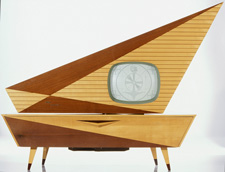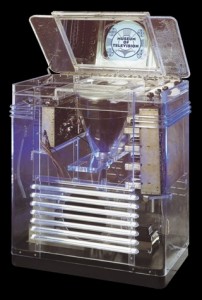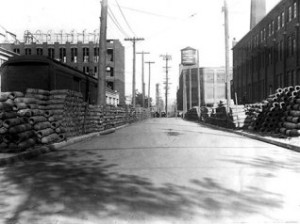Think the iPhone needs a bigger screen? You haven’t watched TV lately…not one of these TVs at any rate.
Some of the earliest televisions had a display not much bigger than a postage stamp; people had to use a magnifying lens to make the image visible.
So Apple leader Tim Cook’s recent statements that the company will wait for the right combination of technology and market demand to enlarge the iPhone screen seem straight out of the notes of John Logie Baird, the English inventor and entrepreneur who many credit – and yes, some blame – for giving us TV back in the 1930s. (Others say it was Philo Farnsworth, a young American inventor, who gave us the first electronic television.)

This German-made Kuba home entertainment unit from the ’50s dominates a living room setting with its wooden ‘sail’ that swivels to accommodate different viewing angles. There’s a radio and phonograph in the unit, too.
Either way, everything old is new again. And if you are into tech these days, you should know this: it’s all been done before!
The proof is on display at the new MZTV Museum of Television, now open in Toronto. It charts the history of TV from the dawn of image transmission to the arrival of the transistor and the contemporary era.
Think Google Glass is cool? The museum has ‘video glasses’ from Sony that are like 20 years old.
Smartwatches? Ha – we’ve been able to strap a TV on our arm for decades, and there’s a small device here to prove it!
There are also jaw-droppingly gorgeous pieces showing sculptural craftsmanship and artistic use of materials, from beautifully grained and stained wood, to clear plastic and transparent Lucite, to highly polished metal – and yes, they are all TVs!
In fact, some of the objects on display are complete home entertainment centres (another of today’s tech concepts that is in fact decades old) with built-in radio tuners, record players (what, you don’t know?) and larger and larger TV screens.
Media mogul and classic TV collector Moses Znaimer’s new Museum officially opened yesterday with a special ceremony at The ZoomerPlex, Znaimer’s broadcast and media home in Liberty Village – a district with its own colourful history.
The collection Moses and his team have put together over the years now consists of more than 360 TV sets, receivers and devices, along with literally thousands of assorted television tubes, lamps, capacitors and much more. It’s one of the world’s largest TV collections, and the largest in terms of TVs made before WWII.
Many of the TVs on display do still work, but even when they are turned off, they tell quite the story. Visitors to the Museum can track interesting global trends in manufacturing capabilities and industrial power.

This RCA ‘telereceiver’ from the late 1930’s is made of clear Lucite, so people could see real electronics – not magicians – inside were used to display moving images on screen.
The earliest TVs were developed and manufactured in England and Europe, for example. The growing dominance of the American manufacturing muscle then becomes apparent, with models from companies like RCA, Philco and Magnavox in the ‘50s and ‘60s. Japan’s growing electronic profile from the ’70s and ’80s is seen on the screens made by Panasonic, JVC and Sony. Now, one supposes, it’s Korea’s turn, with products from LG and Samsung.
And yes, Canada has a small part on this stage: there are TV sets from Electrohome, a Canadian manufacturer that began making B&W (OK, does that need explaining, too?!) back in the late 1940s, and did so until 1984.
Znaimer’s new temple to what he calls “this astonishing technology; the most important cultural phenomenon of the twentieth century” also houses an extensive reference library with books, magazines, photographs and other support material.
(Objects from his collection have been housed and displayed elsewhere over the years, including in the city’s east end Corktown district, next door to Citytv on Queen St W – Moses of course launched City many years ago – he has his own long and colourful TV history!)
In his brief remarks during the Museum’s opening ceremony, Moses noted it was in fact the “Re, re, re….re-opening” of the Museum, quickly adding that “this fledgling institution now has a permanent home.”
But much more than a display of ancient artefacts, the MZTV Museum documents the societal impact of TV, one which still affects us today.
Materials in the Museum’s collection (and posted online at an engagingly interactive companion website) describes not only the technological history of TV, but also paints portraits of the people whose inventiveness and entrepreneurial drive gave us what Moses calls “the most important cultural phenomenon of the twentieth century”.
Not just the 20th – Moses believes the TV still reigns as the dominant medium of our time. Hearing about his “obsession” with TV is like pulling on a string of indeterminate length – he says the entire world is now waking up to the epic impact and significance of television, and he wants the story of how a strange new appliance called television begat what many see today as a ‘necessity of life’ to be more widely known.

Toronto’s Liberty Village area, seen here circa 1915, is now home to trendy condos, innovative media companies, and the new MZTV Museum of Television.
As mentioned, the entire Liberty Village district has its own history (rugs, not TV, were made in the many old factory buildings now redeveloped as trendy condos and office spaces in the area) sprinkled with stories of mystery and murder, as related by Mike Filey, noted Toronto historian, Museum opening attendee, and not coincidentally, radio broadcaster on Zoomer Radio AM, one of the many radio, TV and media outlets Moses still runs today.
The Museum of Television will be open to the public during regularly scheduled hours, and interestingly, it will be available for school group visits by appointment.
For the first time, it will also be participating in Doors Open Toronto this weekend, May 24 & 25th.
# # #
submitted by Lee Rickwood



